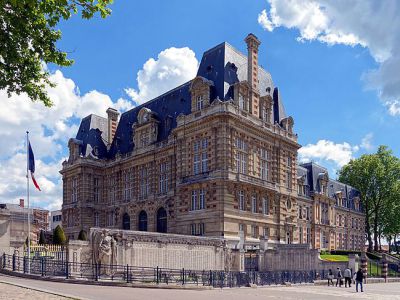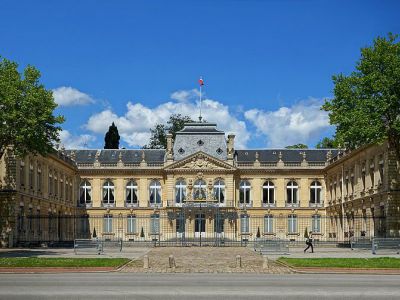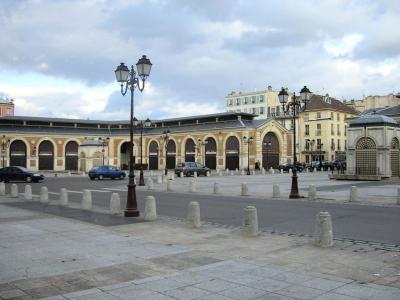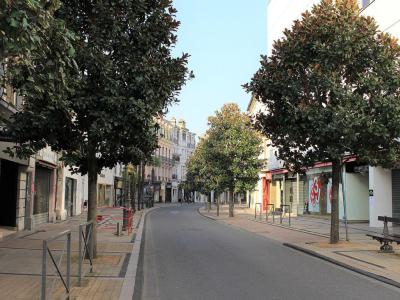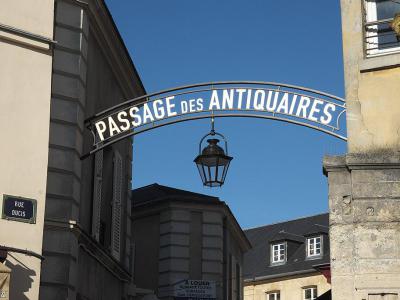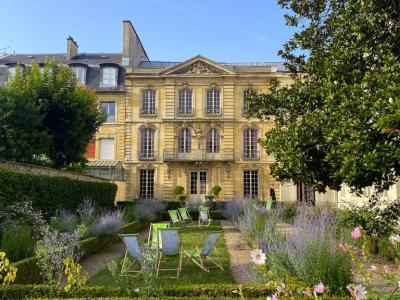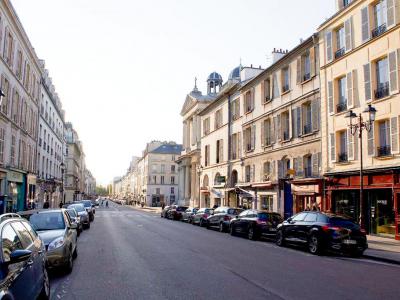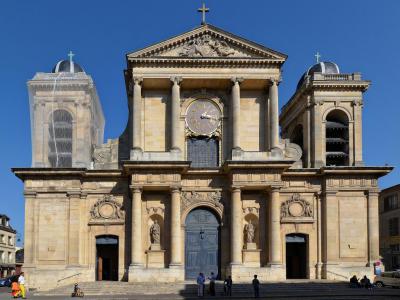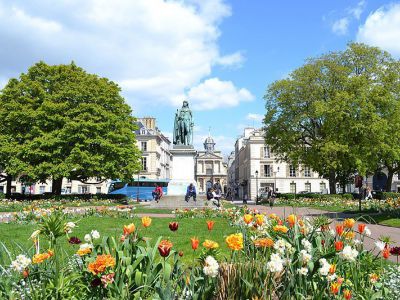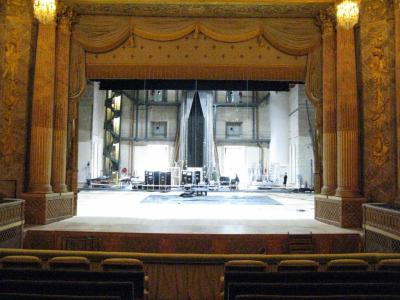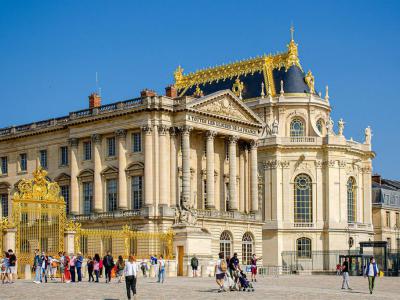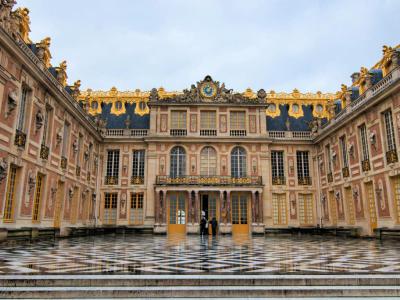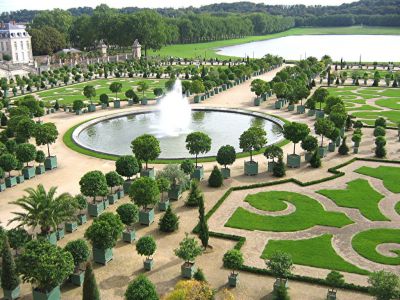
Versailles Introduction Walking Tour (Self Guided), Versailles
Situated on the southwest outskirts of Paris, Versailles is a small city famed for housing the opulent residence of French royalty, the Palace of Versailles. The latter is, by far, Versailles' main attraction, complete with its Hall of Mirrors, Grand Apartments and the Royal Chapel, as well as the spacious formal gardens adorned with fountains and sculptures. Another major attraction is the Musée Lambinet charting the city's history. To learn more about these and other top landmarks of Versailles, follow this orientation walk.
How it works: Download the app "GPSmyCity: Walks in 1K+ Cities" from Apple App Store or Google Play Store to your mobile phone or tablet. The app turns your mobile device into a personal tour guide and its built-in GPS navigation functions guide you from one tour stop to next. The app works offline, so no data plan is needed when traveling abroad.
Versailles Introduction Walking Tour Map
Guide Name: Versailles Introduction Walking Tour
Guide Location: France » Versailles (See other walking tours in Versailles)
Guide Type: Self-guided Walking Tour (Sightseeing)
# of Attractions: 13
Tour Duration: 2 Hour(s)
Travel Distance: 3.8 Km or 2.4 Miles
Author: kane
Sight(s) Featured in This Guide:
Guide Location: France » Versailles (See other walking tours in Versailles)
Guide Type: Self-guided Walking Tour (Sightseeing)
# of Attractions: 13
Tour Duration: 2 Hour(s)
Travel Distance: 3.8 Km or 2.4 Miles
Author: kane
Sight(s) Featured in This Guide:
- City Hall (Hôtel de Ville)
- Prefecture des Yvelines (Hôtel de la Péfecture)
- Place du Marché Notre-Dame
- Rue du Marechal Foch
- Quartier des Antiquaires
- Musée Lambinet
- Rue de la Paroisse
- Eglise Notre-Dame
- Place Hoche
- Royal Opera of Versailles
- Royal Chapel
- Palace of Versailles (Château de Versailles)
- Orangerie Fountain
1) City Hall (Hôtel de Ville)
The Versailles City Hall (Hôtel de Ville) that you will see today isn’t very old, but the original building dated back to the late 17th century and the “new” building has kept much of the early architecture.
The original building was constructed in 1670 for the Marquis de Bellefonds, Bernadin Gigault. It was a beautiful chateau with grounds stretching to the edge of the gardens of the palace.
When the Royal Stables were built, the marquis decided they spoiled his view and he sold the chateau to Philippe of Lorraine, known as the Chevalier de Lorraine. This unscrupulous young man was the lover of Philippe, Duc d’Orleans, Louis 14th’s brother.
In 1680, the duke’s wife used her friendship with the king to have the chevalier imprisoned in the island fortress the Chateau d’If off the coast of Marseille. From there, the chevalier was banished to Rome and Louis 14th annexed the chateau and gave it to his son Louis de Bourbon, the Count of Vermandois.
When the count died a few years later, the chateau became the home of his sister Marie-Anne, the Princess de Conti, who used it for great parties that were the toast of Versailles. Louis de Bourbon and Marie-Anne were Louis 14th children by his mistress Louise de la Vallière.
The princess later sold the chateau to a speculator who stripped the building of its furniture and finery. In 1723 Louis 15th bought it for his Prime Minister, Louis-Hénri de Bourbon. He had it renovated and opened the grounds to the public giving them easier access between the Saint Louis and Notre Dame districts.
During the French Revolution it became the “temporary” seat of the Town Council. In 1821 they were still there and the chateau became the official Hôtel de Ville. In 1899 the building was too small and the Mayor Edouard Lefbvre had it pulled down and commissioned Hénri le Grand to build the new City Hall, based on plans of the chateau.
The original building was constructed in 1670 for the Marquis de Bellefonds, Bernadin Gigault. It was a beautiful chateau with grounds stretching to the edge of the gardens of the palace.
When the Royal Stables were built, the marquis decided they spoiled his view and he sold the chateau to Philippe of Lorraine, known as the Chevalier de Lorraine. This unscrupulous young man was the lover of Philippe, Duc d’Orleans, Louis 14th’s brother.
In 1680, the duke’s wife used her friendship with the king to have the chevalier imprisoned in the island fortress the Chateau d’If off the coast of Marseille. From there, the chevalier was banished to Rome and Louis 14th annexed the chateau and gave it to his son Louis de Bourbon, the Count of Vermandois.
When the count died a few years later, the chateau became the home of his sister Marie-Anne, the Princess de Conti, who used it for great parties that were the toast of Versailles. Louis de Bourbon and Marie-Anne were Louis 14th children by his mistress Louise de la Vallière.
The princess later sold the chateau to a speculator who stripped the building of its furniture and finery. In 1723 Louis 15th bought it for his Prime Minister, Louis-Hénri de Bourbon. He had it renovated and opened the grounds to the public giving them easier access between the Saint Louis and Notre Dame districts.
During the French Revolution it became the “temporary” seat of the Town Council. In 1821 they were still there and the chateau became the official Hôtel de Ville. In 1899 the building was too small and the Mayor Edouard Lefbvre had it pulled down and commissioned Hénri le Grand to build the new City Hall, based on plans of the chateau.
2) Prefecture des Yvelines (Hôtel de la Péfecture)
You can visit the Préfecture des Yvelines (Hôtel de la Préfecture) on guided tours or you can nip in on some excuse or other just to look around the main entrance.
The enormous three sided building was constructed between 1863 and 1866 on the former site of the Royal Kennels. It was commissioned by the Préfet Edouard Charton and built by Amédée Manuel. The figures on the triangular pediment above the main entrance represent La Seine and l’Oise; the two busts below represent Commerce and Industry.
The interior of the building is quite magnificent with ceiling frescoes by Ernest Gendron, Gaston Jobbé Duval and Dominique Guifard. The walls are bedecked with many important paintings, including naval battle scenes by Théodore Gudin and four paintings of the Four Seasons by Legray. There are also superb objets d’art including a fine statuette in Sevrès Porcelain by Louis-Simon Boizot.
During the Franco-Prussian War in 1870 the building was occupied by the forces of the Prussian king, who was crowned William 1st German Emperor in 1871 in the Hall of Mirrors at the Chateau of Versailles.
The newly crowned emperor and his army moved out and the building was then occupied by the 1st President of the 3rd Republic, Adolphe Thiers and his government during the Commune of Paris. His successor Patrice Mac Mahon also governed from here until 1875.
In 1880 it became the seat of the Préfecture of Seine-et-Oise, until it was taken over by the newly created Préfecture des Yvelines in 1968.
The enormous three sided building was constructed between 1863 and 1866 on the former site of the Royal Kennels. It was commissioned by the Préfet Edouard Charton and built by Amédée Manuel. The figures on the triangular pediment above the main entrance represent La Seine and l’Oise; the two busts below represent Commerce and Industry.
The interior of the building is quite magnificent with ceiling frescoes by Ernest Gendron, Gaston Jobbé Duval and Dominique Guifard. The walls are bedecked with many important paintings, including naval battle scenes by Théodore Gudin and four paintings of the Four Seasons by Legray. There are also superb objets d’art including a fine statuette in Sevrès Porcelain by Louis-Simon Boizot.
During the Franco-Prussian War in 1870 the building was occupied by the forces of the Prussian king, who was crowned William 1st German Emperor in 1871 in the Hall of Mirrors at the Chateau of Versailles.
The newly crowned emperor and his army moved out and the building was then occupied by the 1st President of the 3rd Republic, Adolphe Thiers and his government during the Commune of Paris. His successor Patrice Mac Mahon also governed from here until 1875.
In 1880 it became the seat of the Préfecture of Seine-et-Oise, until it was taken over by the newly created Préfecture des Yvelines in 1968.
3) Place du Marché Notre-Dame (must see)
The Place du Marché Notre-Dame is a fantastic covered marketplace and open-air market that has served the town for more than 150 years. This colorful market offers all kinds of delicious food products, including snails!
4) Rue du Marechal Foch
If you're looking for shopping other than souvenir scavenging there are several shops located around the city center. Most of these shops are located along the Boulevard de La Reine, the Rue Chantiers, Rue du Maréchal Foch, and the Rue du Mar. Joffre.
Sight description based on Wikipedia.
5) Quartier des Antiquaires
The Quartier des Antiquaires is the only place in town you need to visit if you want to go antique shopping. Located near the Musée Lambinet and the Eglise Notre-Dame, this great shopping spot has something for amateurs and professionals alike among its wide range of rare antique items.
6) Musée Lambinet (must see)
If you haven’t got enough time to visit all of Versailles, or if there are too many people queuing up to visit the Chateau, or if you are quite simply overwhelmed by the history of this famous area; then the Musée Lambinet is the place to visit.
The museum is housed in the Hôtel Lambinet, a hôtel particulier, which means a very grand townhouse for the nobility. It was designed in 1751 by Elie Blanchard for Joseph Porchon, a wealthy constructor. On the garden façade the pediment bears a sculpture representing Architecture. The hôtel was built on the site of a drained lake.
In 1852 the townhouse was bought by Jean-François Lambinet, who had been the Mayor of Versailles until 1848. The building was bequeathed to the town by his heirs in 1929 and it became a museum in 1932.
The museum’s 35 rooms have been intelligently divided into three sections: the first part is dedicated to fine arts from the 16th to the 20th century. The second section has a beautiful recreation of an 18th century apartment with decorative art, furnishings and paintings typical of the epoch.
The third section deals with the history of Versailles, its beginnings, its place during the Revolution and the 1st Empire and the influence its inhabitants had on the outcome of the American War for Independence.
You will see maps, plans and charters, all with explications that will help you to understand not only the beauty of Versailles but also the important role the kings of France played in the shaping of our society.
The museum is housed in the Hôtel Lambinet, a hôtel particulier, which means a very grand townhouse for the nobility. It was designed in 1751 by Elie Blanchard for Joseph Porchon, a wealthy constructor. On the garden façade the pediment bears a sculpture representing Architecture. The hôtel was built on the site of a drained lake.
In 1852 the townhouse was bought by Jean-François Lambinet, who had been the Mayor of Versailles until 1848. The building was bequeathed to the town by his heirs in 1929 and it became a museum in 1932.
The museum’s 35 rooms have been intelligently divided into three sections: the first part is dedicated to fine arts from the 16th to the 20th century. The second section has a beautiful recreation of an 18th century apartment with decorative art, furnishings and paintings typical of the epoch.
The third section deals with the history of Versailles, its beginnings, its place during the Revolution and the 1st Empire and the influence its inhabitants had on the outcome of the American War for Independence.
You will see maps, plans and charters, all with explications that will help you to understand not only the beauty of Versailles but also the important role the kings of France played in the shaping of our society.
7) Rue de la Paroisse (must see)
Rue de la Paroisse is a shopping street in the center of Versaille. There are around 300 shops in the Rue Carnot, the Rue Hoche and the Rue de la Paroisse area. This quarter is known as the known as the Triangle d'Or of Versaille. There is enough choice here to easily while away an entire day. There is a little concentration of bars (and restaurants) on the Place du Marché, at the junction of the Rue de la Paroisse, and Rue du Maréchal Foch. This is where most young people go out at night. Tables outside the terraces are plentiful in the nice months.
8) Eglise Notre-Dame (must see)
Although the Eglise Notre-Dame isn’t as grand as the cathedral, it is by far more lavishly decorated and less austere.
The church was commissioned by Louis 14th in 1686 and built by Maurice Gabriel on plans by Jules Hardouin-Mansart. It is 80 metres long, 34 metres wide and 19 metres high under the vault.
The sculptures in the quire of Faith and Hope were installed in 1786; the bas-reliefs of Religion and Charity were carved a little later.
The nave is wide with a barrel vault ceiling. Only the paneling, the organ case and the pulpit are the originals, the rest of the furnishing was destroyed during the French Revolution. The pillars are decorated with marble medallions of Mary Magdalen and the 12 Apostles; they were created by the Royal Academy of Painting and Sculpture, which is now a part of the Academy of Beaux-Arts.
The marble statue of Christ by Magmer came from the Priory of Longjumeau in 1695. In the Chapel of the Sacred Sacrament you can admire a painting of The Assumption by Michel Corneille. In the Mansart Chapel there is an embroidered silk banner donated by Pope Pius 6th which was hidden during the French Revolution.
Another prized possession that survived the Revolution is the fine cenotaph raised for Louis 16th’s Foreign Minister, Vergennes, who died in 1787. There is another memorial of note that contains the heart of General Hoche.
The church was commissioned by Louis 14th in 1686 and built by Maurice Gabriel on plans by Jules Hardouin-Mansart. It is 80 metres long, 34 metres wide and 19 metres high under the vault.
The sculptures in the quire of Faith and Hope were installed in 1786; the bas-reliefs of Religion and Charity were carved a little later.
The nave is wide with a barrel vault ceiling. Only the paneling, the organ case and the pulpit are the originals, the rest of the furnishing was destroyed during the French Revolution. The pillars are decorated with marble medallions of Mary Magdalen and the 12 Apostles; they were created by the Royal Academy of Painting and Sculpture, which is now a part of the Academy of Beaux-Arts.
The marble statue of Christ by Magmer came from the Priory of Longjumeau in 1695. In the Chapel of the Sacred Sacrament you can admire a painting of The Assumption by Michel Corneille. In the Mansart Chapel there is an embroidered silk banner donated by Pope Pius 6th which was hidden during the French Revolution.
Another prized possession that survived the Revolution is the fine cenotaph raised for Louis 16th’s Foreign Minister, Vergennes, who died in 1787. There is another memorial of note that contains the heart of General Hoche.
9) Place Hoche
Place Hoche, formerly known as Place Dauphine, is one of the town’s most prominent squares. Located in the heart of Versailles near the marvelous Eglise Notre-Dame, this fine square was laid out during the reign of Louis XIV. It was arranged according to an octagonal town plan in force at the time. You will notice a statue of Louis Lazare Hoche, a prominent French soldier, in the center of the square.
10) Royal Opera of Versailles (must see)
The Royal Opera of Versailles is well worth a visit, not only for the beauty its interior, but also for the feeling of stepping back in time. You half-expect to see nobles and their ladies settling into the seats to enjoy a long forgotten opera.
The opera house was built in 1770, designed by Ange-Jacques Gabriel and the interior decorator Augustin Pajou. It seated 712 guests in the oval auditorium and the floor where the orchestra played could be raised to the level of the stage to make more space.
The wooden walls were painted to resemble marble and the decoration was heavily mythological representing the Olympian gods and goddesses. The ceiling canvas executed by Louis Jean-Jacques Durameau featured Apollo and the Muses.
The building was inaugurated on Louis 16th‘s wedding day and the King’s Lodge and Boudoir are excellent examples of what came to be called the “Louis XVI style”.
The opera was closed when the Royal family left Versailles in 1789 and remained unused until 1837, when Louis-Philippe had it renovated. In 1872 it was converted for the use of the Assemblée Nationale who convened here until 1876.
From then until 1879 it was the seat of the Senate. When they left the building it was neglected until 1952 when André Japy carried out extensive renovation work to restore it to its original beauty.
The opera house was built in 1770, designed by Ange-Jacques Gabriel and the interior decorator Augustin Pajou. It seated 712 guests in the oval auditorium and the floor where the orchestra played could be raised to the level of the stage to make more space.
The wooden walls were painted to resemble marble and the decoration was heavily mythological representing the Olympian gods and goddesses. The ceiling canvas executed by Louis Jean-Jacques Durameau featured Apollo and the Muses.
The building was inaugurated on Louis 16th‘s wedding day and the King’s Lodge and Boudoir are excellent examples of what came to be called the “Louis XVI style”.
The opera was closed when the Royal family left Versailles in 1789 and remained unused until 1837, when Louis-Philippe had it renovated. In 1872 it was converted for the use of the Assemblée Nationale who convened here until 1876.
From then until 1879 it was the seat of the Senate. When they left the building it was neglected until 1952 when André Japy carried out extensive renovation work to restore it to its original beauty.
11) Royal Chapel (must see)
The chapel of the Palace of Versailles is an ornate early 18th Century masterpiece. Dedicated to Saint Louis, patron saint of the Bourbons, the chapel was consecrated in 1710. Its upper level, known as the “salon de la chapelle”, is decorated with white stone and a bas-relief sculpture. The floor of the chapel is inlaid with marble, while at the foot of the steps leading to the altar is a crowned monogram of an interlaced double “L”, alluding to both Saint Louis and Louis XIV. During the 18th Century, the chapel witnessed many official events. Hymns were sung here to celebrate military victories and royal births, for example. Marriages were also celebrated in this chapel, such as the wedding of Louis XV’s son Louis-Ferdinand with the Infanta Marie-Thérèse of Spain in 1745, and the wedding of the would-be Louis XVI with Marie-Antoinette in 1770.
Sight description based on Wikipedia.
12) Palace of Versailles (Château de Versailles) (must see)
Although Versailles existed as a village in the early 11th century, it wasn’t until King Louis 13th built a hunting lodge here in 1624 that the history of the Palace of Versailles (Chateau de Versailles) really began.
The king obtained seigniory of the land in 1632 and had the lodge enlarged into a chateau. His son (the future Louis 14th) played here as a child and he loved the place. When he became king he contracted the great architect Louis le Vau and the innovative landscape gardener André le Notre to change the chateau and grounds into the magnificent palace and gardens you can visit today.
Of course this didn’t happen overnight and the king devoted most of his life to the project. The most significant building work took place between 1669 and 1672, when the hunting lodge was enveloped on three sides – the north, the south and the west.
The Grand Apartment du Roi was built in the north part of the Piano Nobile with the Grand Apartment de la Reine in the south part. The western part was a terrace until it was enclosed to house the Hall of Mirrors (Galerie des Glaces) in 1678.
The architect of this beautiful hall was Jules Hardouin-Mansart and as well as enclosing the terrace, he took three rooms from the king’s and three from the queen’s. The hall comprises 17 arched mirrors facing 17 arched windows that reflect the sun and fill the hall with golden light.
To get away from the over-crowded city of Paris, Louis 14th began to move his court here in 1678. From then until the beginning of the French Revolution when the Royal family was forced to leave the palace, the kings of France reigned from here and it was the centre of political power.
The king obtained seigniory of the land in 1632 and had the lodge enlarged into a chateau. His son (the future Louis 14th) played here as a child and he loved the place. When he became king he contracted the great architect Louis le Vau and the innovative landscape gardener André le Notre to change the chateau and grounds into the magnificent palace and gardens you can visit today.
Of course this didn’t happen overnight and the king devoted most of his life to the project. The most significant building work took place between 1669 and 1672, when the hunting lodge was enveloped on three sides – the north, the south and the west.
The Grand Apartment du Roi was built in the north part of the Piano Nobile with the Grand Apartment de la Reine in the south part. The western part was a terrace until it was enclosed to house the Hall of Mirrors (Galerie des Glaces) in 1678.
The architect of this beautiful hall was Jules Hardouin-Mansart and as well as enclosing the terrace, he took three rooms from the king’s and three from the queen’s. The hall comprises 17 arched mirrors facing 17 arched windows that reflect the sun and fill the hall with golden light.
To get away from the over-crowded city of Paris, Louis 14th began to move his court here in 1678. From then until the beginning of the French Revolution when the Royal family was forced to leave the palace, the kings of France reigned from here and it was the centre of political power.
13) Orangerie Fountain (must see)
The buildings and gardens of Versailles are beautiful and diverse. The Orangerie is one of the finest examples of the whims of the kings of France.
King Louis 14th transformed the hunting lodge used by his grandfather Louis 13th, into the magnificent Palace of Versailles during three separate building campaigns. One of the first buildings to be completely finished was the Orangerie, built between 1684 and 1686, by the king’s favorite architect Jules Hardouin Mansart.
The building consists of a central gallery, 150 metres long and 21 metres wide with a high vaulted ceiling and tall arched windows facing the south for maximum sunlight. This gallery has two lateral galleries 117 metres long, which are under the famous “Cent Marches” stairway.
The gardens are spread around a central pond with a fountain. Around the pond are walkways and four lawns that are laid out in geometrical patterns. From May to October plants are brought out from the buildings and set out in large square tubs lining the paths.
Some of these plants and trees are over 200 years old and every year they are laden with fruit or flowers. You can admire Oleanders with their crêpe-paper red, pink and white blossoms, slender palms and orange, lemon and pomegranate trees from Italy, Spain and Portugal.
King Louis 14th transformed the hunting lodge used by his grandfather Louis 13th, into the magnificent Palace of Versailles during three separate building campaigns. One of the first buildings to be completely finished was the Orangerie, built between 1684 and 1686, by the king’s favorite architect Jules Hardouin Mansart.
The building consists of a central gallery, 150 metres long and 21 metres wide with a high vaulted ceiling and tall arched windows facing the south for maximum sunlight. This gallery has two lateral galleries 117 metres long, which are under the famous “Cent Marches” stairway.
The gardens are spread around a central pond with a fountain. Around the pond are walkways and four lawns that are laid out in geometrical patterns. From May to October plants are brought out from the buildings and set out in large square tubs lining the paths.
Some of these plants and trees are over 200 years old and every year they are laden with fruit or flowers. You can admire Oleanders with their crêpe-paper red, pink and white blossoms, slender palms and orange, lemon and pomegranate trees from Italy, Spain and Portugal.
Walking Tours in Versailles, France
Create Your Own Walk in Versailles
Creating your own self-guided walk in Versailles is easy and fun. Choose the city attractions that you want to see and a walk route map will be created just for you. You can even set your hotel as the start point of the walk.
Versailles Garden Fountains Tour
Besides its many wonderful plants and trees landscaped into amazing patterns, the gardens at the Royal Palace of Versailles have another key ingredient: water. The marvelous fountains and other fantastic water features here only serve to underline the magnificent beauty of the whole complex. Take our tour to see the best water features in the royal gardens.
Tour Duration: 4 Hour(s)
Travel Distance: 10.1 Km or 6.3 Miles
Tour Duration: 4 Hour(s)
Travel Distance: 10.1 Km or 6.3 Miles
The Most Popular Cities
/ view all
